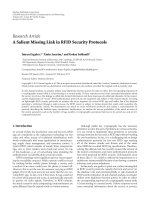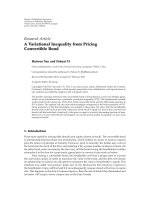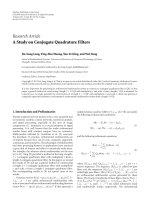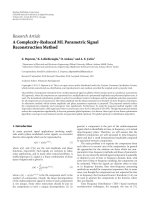Báo cáo hóa học: " Research Article A Study on Conjugate Quadrature Filters" docx
Bạn đang xem bản rút gọn của tài liệu. Xem và tải ngay bản đầy đủ của tài liệu tại đây (1.2 MB, 7 trang )
Hindawi Publishing Corporation
EURASIP Journal on Advances in Signal Processing
Volume 2011, Article ID 231754, 7 pages
doi:10.1155/2011/231754
Research Article
A Study on Conjugate Quadrature Filters
Jin-Song Leng, Ting-Zhu Huang, Yan-Fei Jing, and Wei Jiang
School of Mathematical Sciences, University of Electronic of Science and Technology of China,
Chengdu, Sichuan 610054, China
Correspondence should be addressed to Jin-Song Leng,
Received 18 June 2010; Revised 26 October 2010; Accepted 5 January 2011
Academic Editor: Antonio Napolitano
Copyright © 2011 Jin-Song Leng et al. This is an open access article distributed under the Creative Commons Attribution License,
which permits unrestricted use, distribution, and reproduction in any medium, provided the original work is properly cited.
It is very important for generating an orthonormal multiwavelet system to construct a conjugate quadrature filter (CQF). In this
paper, a general method of constructing a length-J + 1 CQF with multiplicity r and scale a from a length-J CQF is obtained. As
a special case, we study generally the construction of a length-J + 1 CQF with multiplicity 2 and scale 2 which can generate a
compactly supported symmetric-antisymmetric orthonormal multiwavelet system from a length-J CQF.
1. Introduction and Preliminaries
Wavelet analysis has been proven to be a very powerful tool
in harmonic analysis, neural networks, numerical analysis,
and signal processing, especially in the area of image
compression [1]. Symmetry is a crucial property in signal
processing. It is well known that the scalar orthonormal
wavelet bases with compact support have no symmetry.
Multiwavelets initiated by Goodman et al. [2]overcome
the drawback. In practice, orthonormal multiwavelets are
of interest because they can be real, compactly supported,
continuous, and symmetric. The advantages of multiwavelets
and their promising features in applications have attracted
a great deal of interest and effort to extensively study them.
For example, the advances about multiwavelets can be seen
in [3–11]. Yang [9] provided a method of deriving a length-
J + 1 conjugate quadrature filter with multiplicity r from a
length-J conjugate quadrature filter. In this paper, we extend
the results of [9] and get a general method of constructing
a length-J + 1 conjugate quadrature filter with multiplicity
r and scale a from a length-J conjugate quadrature filter.
The corresponding results in [9] are special cases of our
results.
Function vectors Ψ
l
(x)=(ψ
l,1
(x), ψ
l,2
(x), , ψ
l,r
(x))
T
, l=
1, 2, , a − 1 are called orthonormal multiwavelets with
scale a associated with an orthonormal multiscaling function
vector Φ(x)
= (φ
1
(x), φ
2
(x), , φ
r
(x))
T
if they generate a
multiresolution analysis (MRA)
{V
j
}
j∈Z
of L
2
(R) and satisfy
the following orthonormal conditions:
Φ
(
·−k
)
, Φ
(
·−l
)
=δ
k,l
I
r
,
Ψ
k
(
·−m
)
, Ψ
l
(
·−n
)
=δ
k,l
δ
m,n
I
r
,
(1)
and the following refinement equations:
Φ
(
x
)
=
1
a
k∈Z
P
k
Φ
(
ax −k
)
,
Ψ
l
(
x
)
=
1
a
k∈Z
Q
l,k
Φ
(
ax −k
)
, l = 1, 2, , a − 1,
(2)
where
{P
k
}
k∈Z
and {Q
l,k
}
k∈Z
, l = 1, 2, , a − 1arer × r
matrix sequences. The sequence
{P
k
}
k∈Z
is called low-pass
filter, and the sequences
{Q
l,k
}
k∈Z
, l = 1, 2, , a − 1are
called high-pass filters.
{Φ(x), Ψ
1
(x), Ψ
2
(x), , Ψ
a−1
(x)} is
an orthonormal multiwavelet system generated by these
filters. The Fourier transforms of these filters, that is, P(ω)
=
(1/a)
k∈Z
P
k
e
−ikω
are Q
l
(ω) = (1/a)
k∈Z
Q
l,k
e
−ikω
, l =
1, 2, , a − 1, and i =
√
−1 are called refinement mask
and multiwavelet masks, respectively. The orthonormal
2 EURASIP Journal on Advances in Signal Processing
conditions (1) imply the following conditions called the
perfect reconstruction (PR) conditions [2, 6]:
a−1
k=0
P
ω +2kπ
a
P
∗
ω +2kπ
a
=
I
r
,(3)
a−1
k=0
P
ω +2kπ
a
Q
∗
l
ω +2kπ
a
=
0
r
,
l
= 1, 2, , a − 1,
(4)
a−1
k=0
Q
l
ω +2kπ
a
Q
∗
m
ω +2kπ
a
=
δ
l,m
I
r
,
l, m
= 1, 2, , a − 1.
(5)
If the sequence
{P
k
}
k∈Z
satisfies (3), it is called a matrix
conjugate quadrature filter (CQF). In this paper, we suppose
P
k
= 0
r
for all k<0ork>J,whereJ ∈ Z
+
. For the matrix
CQF
{P
k
}
J
k
=0
with multiplicity r = 2 and scale a = 2, the
following conditions:
P
0
, P
J
are nonzero matrices
(6)
P
k
= AP
J−k
A, k = 0, 1, , J,whereA =
⎡
⎣
10
0
−1
⎤
⎦
,
(7)
P
(
0
)
=
⎡
⎣
10
0 α
⎤
⎦
, for some number |α| < 1(8)
are called SA conditions [8]. The condition (7)implies
that the corresponding multiscaling function vector forms a
symmetric-antisymmetric pair as shown in the following [5]:
P
k
= AP
J−k
A, k = 0, 1, , J
⇐⇒ P
(
ω
)
= AP
(
−ω
)
Ae
−iJω
⇐⇒ φ
i
(
x
)
=
(
−1
)
i−1
φ
i
(
J
− x
)
, i = 1, 2.
(9)
The condition (8) is a necessary condition [7]foralow-
pass filter satisfying (6)and(7) to generate a multiresolution
analysis.
The paper is organized as follows. In Section 2,we
provide a general method of constructing a length-J +1
CQF with complicity r and scale a from a length-J CQF. In
Section 3, as the application of Section 2,westudygenerally
the construction of a length-J + 1 CQF with multiplicity
2 and scale 2 which can generate a compactly supported
symmetric-antisymmetric orthonormal multiwavelet system
from a length-J CQF. In Section 4,wegivetwonumerical
examples.
2. A Study on Matrix Conjugate Quadrature
Filters with Arbitrary Multiplicity and
Arbitrary Scale
Lemma 1. Let M(ω) be a r × r matrix whose entries are
linear polynomials of e
−iω
with real coefficients, then M(ω) is a
unitary matrix if and only if
M
(
ω
)
= M
(
0
)
I
r
− H + He
−iω
, (10)
where the r
× r matrix M(0) satisfies
M
(
0
)
M
T
(
0
)
= I
r
,
(11)
and the r
× r matrix H satisfies
H
T
= H, H
2
= H.
(12)
Proof. It is obvious that the right side of (10) is a unitary
matrix. We only prove the forward direction. Assume that
M(ω) is a unitary matrix, then M(0) satisfies (11), and then
we have
M
(
ω
)
= M
(
0
)
F + He
−iω
, (13)
where F, H are r
×r matr ices whose entries are real numbers.
Let ω
= 0, then we have
F
= I
r
− H. (14)
Then
M
∗
(
ω
)
M
(
ω
)
=
I
r
− H
T
+ H
T
e
iω
M
T
(
0
)
M
(
0
)
I
r
− H + He
−iω
=
I
r
− H − H
T
+2H
T
H +
H − H
T
H
e
−iω
+
H
T
− H
T
H
e
iω
= I
r
,
(15)
which implies
H
= H
T
H = H
T
.
(16)
Hence H satisfies (12).
Theorem 1. Suppose that the r ×r matrix sequence {P
O,k
}
J−1
k
=0
is a length-J CQF, M is an r × r matrix satisfying (11),andH
is an r
× r matrix satis fying (12).Let
P
N,k
=
⎧
⎪
⎪
⎪
⎪
⎨
⎪
⎪
⎪
⎪
⎩
P
O,0
M
(
I
r
− H
)
, k = 0,
P
O,k−1
MH + P
O,k
M
(
I
r
− H
)
,0<k<J
P
O,J−1
MH, k = J,
, (17)
EURASIP Journal on Advances in Signal Processing 3
then the r
×r matrix sequence {P
N,k
}
J
k
=0
is a length-J +1CQF.
Remark 1. We adopt the subscript “O”in
{P
O,k
}
J−1
k
=0
to
indicate that it is an old CQF, and adopt the subscript “N”
in
{P
N,k
}
J
k
=0
to indicate that it is a new CQF.
Proof. Let
M
(
ω
)
= M
I
r
− H + He
−iω
. (18)
By Lemma 1, M(ω) is a unitary matrix. Using (17), we have
P
N
(
ω
)
= P
O
(
ω
)
M
(
ω
)
. (19)
Then
a−1
k=0
P
N
ω +2kπ
a
P
∗
N
ω +2kπ
a
=
I
r
. (20)
Therefore,
{P
N,k
}
J
k
=0
satisfies (3). Hence {P
N,k
}
J
k
=0
is a
length-J +1CQF.
3. Some Results on Matrix Conjugate
Quadrature Filters with Multiplicity 2
and Scale 2
Lemma 2 (see [5]). Let{P
k
}
J
k
=0
be a 2 × 2 matrix sequence,
then the following two statements are equivalent:
(i) P
k
= AP
J−k
A, k = 0, 1, , J, where A =
10
0
−1
.
(ii) P(ω)
= AP(−ω)Ae
−iJω
,whereP(ω) is the Fourier
transform of
{P
k
}
J
k
=0
.
Theorem 2. Let
{P
O,k
}
J−1
k
=0
be a CQF with multiplicity r = 2
and scale a
= 2 satisfying SA conditions and let M, H be two
2
× 2 matrices satisfying (11) and (12),respectively.Thenthe
new CQF
{P
N,k
}
J
k
=0
constructed by (17) satisfies SA conditions
if and only if
M
=
⎡
⎣
10
0
±1
⎤
⎦
, H =
⎡
⎢
⎢
⎣
1
2
±
1
2
±
1
2
1
2
⎤
⎥
⎥
⎦
. (21)
Proof. We first prove the reverse direction. Let
M
=
⎡
⎣
10
01
⎤
⎦
, H =
⎡
⎢
⎢
⎣
1
2
1
2
1
2
1
2
⎤
⎥
⎥
⎦
, (22)
then
M
(
ω
)
=
⎡
⎢
⎢
⎣
1
2
+
1
2
e
−iω
−
1
2
+
1
2
e
−iω
−
1
2
+
1
2
e
−iω
1
2
+
1
2
e
−iω
⎤
⎥
⎥
⎦
, (23)
which satisfies
AM
(
ω
)
= M
(
−ω
)
Ae
−iω
. (24)
Using Lemma 2 as well as (19)and(23), we have
P
N
(
ω
)
= P
O
(
ω
)
M
(
ω
)
= AP
N
(
−ω
)
Ae
−iJω
. (25)
Hence
{P
N,k
}
J
k
=0
satisfies (7)byLemma 2.Because{P
O,k
}
J−1
k
=0
satisfies (8), we have
P
N
(
0
)
= P
O
(
0
)
M
(
0
)
= P
O
(
0
)
=
⎡
⎣
10
0 α
⎤
⎦
,
for some number
|α| < 1.
(26)
Hence
{P
N,k
}
J
k
=0
satisfies (8). It is obvious that {P
N,k
}
J
k
=0
satisfies (6). So {P
N,k
}
J
k
=0
satisfies SA conditions. The proof
of the other cases of M, H in (21) is similar.Then we prove
the forward direction. Suppose that the new CQF
{P
N,k
}
J
k
=0
constructed by (17) satisfies SA conditions. Let M =
ab
cd
,
then
P
N
(
0
)
= P
O
(
0
)
M
=
⎡
⎣
ab
αc αd
⎤
⎦
, (27)
which satisfies (8). Noting that M satisfies (11), we can get
a
= 1, d =±1, b = c = 0. (28)
Hence
M
=
⎡
⎣
10
0
±1
⎤
⎦
. (29)
Because H satisfies (12), we have
H
=
⎡
⎣
a ±
√
a − a
2
±
√
a − a
2
1 − a
⎤
⎦
,or
H = I
r
, a>0.
(30)
Hence
M
(
ω
)
= M
⎡
⎢
⎢
⎢
⎣
1 − a + ae
−iω
∓
√
a − a
2
±
√
a − a
2
e
−iω
√
a − a
2
±
√
a − a
2
e
−iω
a +
(
1 − a
)
e
−iω
⎤
⎥
⎥
⎥
⎦
,
or M
(
ω
)
= Me
−iω
.
(31)
Because
{P
N,k
}
J
k
=0
satisfies (7), by Lemma 2 and ( 19 ), we
have
P
N
(
ω
)
= AP
N
(
−ω
)
Ae
−iJω
= AP
O
(
−ω
)
AM
(
ω
)
e
−i(J−1)ω
.
(32)
Hence
AM
(
ω
)
= M
(
−ω
)
Ae
−iω
. (33)
4 EURASIP Journal on Advances in Signal Processing
0
1
2
3
0 0.5 1 1.5 2
Scalar calibration
φ
1
(a)
0
1
2
3
0 0.5 1 1.5 2
Scalar calibration
φ
2
−1
(b)
Figure 1: The scaling functions on interval [0, 2] generated by the new lengh-5 low-pass filter.
Using (31)and(33), we have
H
=
⎡
⎢
⎢
⎣
1
2
±
1
2
±
1
2
1
2
⎤
⎥
⎥
⎦
. (34)
Similarly to the above theorem, we can get the following
theorem.
Theorem 3. Suppose that {P
O,k
}
J−1
k
=0
and {Q
O,l,k
}
L−1
k
=0
, l =
1, 2, , a − 1, L ∈ Z
+
generate a symmet ric-antisymmetric
orthonormal multiwavelet system with multiplicity r
= 2 and
scale a
= 2. {P
N,k
}
J
k
=0
and {Q
N,l,k
}
L
k
=0
, l = 1, 2, , a − 1
are given by (17) from
{P
O,k
}
J−1
k
=0
and {Q
O,l,k
}
L−1
k
=0
,respectively.
Then
{P
N,k
}
J
k
=0
and {Q
N,l,k
}
L
k
=0
, l = 1, 2, , a − 1 generate
a new symmetric-antisymmetric orthonormal multiwavelet
system.
4. Numerical Examples
Example 1. The following CQF was constructed in [3]by
fractal interpolation:
P
0
=
1
20
⎡
⎣
12 16
√
2
−
√
2 −6
⎤
⎦
, P
1
=
1
20
⎡
⎣
12 0
9
√
220
⎤
⎦
,
P
2
=
1
20
⎡
⎣
00
9
√
2 −6
⎤
⎦
, P
3
=
1
20
⎡
⎣
00
−
√
20
⎤
⎦
.
(35)
Let
M
=
⎡
⎢
⎢
⎢
⎣
1
2
−
√
3
2
√
3
2
1
2
⎤
⎥
⎥
⎥
⎦
, H =
⎡
⎢
⎢
⎢
⎣
1
4
−
√
3
4
−
√
3
4
3
4
⎤
⎥
⎥
⎥
⎦
, (36)
we get the following new length-5 CQF w ith (17):
P
0
=
1
20
⎡
⎣
8
√
68
√
2
−3
√
3 −3
⎤
⎦
,
P
1
=
1
20
⎡
⎢
⎣
6 −6
√
3
10
√
3 −
√
2
2
10 +
√
6
2
⎤
⎥
⎦
,
P
2
=
1
20
⎡
⎢
⎣
6 −6
√
3
−3
√
3+
9
√
2
2
−3 −
9
√
6
2
⎤
⎥
⎦
,
P
3
=
1
20
⎡
⎢
⎣
00
9
√
2
2
−
9
√
6
2
⎤
⎥
⎦
,
P
4
=
1
20
⎡
⎢
⎣
00
−
√
2
2
√
6
2
⎤
⎥
⎦
.
(37)
The scaling functions generated by the lengh-5 low-pass
filter are shown in Figure 1.
In signal processing, an original signal is decomposed by
the low-pass filters and the high-pass filters into different
frequency components, and then each component with a
resolution matched to its scale is studied. Given a test signal
which is the function
f
(
t
)
= sin t +sin3t +sin5t (38)
we decompose the test signal with the old lengh-4 low-pass
filter and the new lengh-5 low-pass filter of the example. The
results are shown in Figure 2.
EURASIP Journal on Advances in Signal Processing 5
0
10 20 30 40
−2
0
1
2
−1
Scalar calibration
(a) The test signal
0
10 20 30 40
−0.5
0.5
0
−1
Scalar calibration
(b) Decomposition with the old lengh-4 low-pass filter
0 10203040
−2
0
1
2
−1
Scalar calibration
(c) Decomposition with the new lengh-5 low-pass filter
Figure 2: Decompositions of the test signal, prefiltered with Haar on interval [0, 40].
0
0
0.5
0.5
1
1
1.5
1.5
2
−0.5
φ
1
Scalar calibration
(a)
0
0 0.5
1 1.5
2
−2
−4
2
4
φ
2
Scalar calibration
(b)
Figure 3: The scaling functions on interval [0, 2] generated by the lengh-3 low-pass filter with θ = π/6.
6 EURASIP Journal on Advances in Signal Processing
ψ
1
0 0.5
1 1.5
2
Scalar calibration
−2
−1
0
1
2
(a)
ψ
2
0 0.5
1 1.5
2
Scalar calibration
0
−2
−4
2
4
(b)
Figure 4: The wavelet functions on interval [0, 2] gener ated by the lengh-3 high-pass filter with θ = π/6.
0
10 20 30 40
Scalar calibration
−2
0
2
(a) The test signal
0
10 20 30 40
Scalar calibration
−2
0
2
(b) Decomposition with the old lengh-2 low-pass filter
0
10 20 30 40
Scalar calibration
−2
0
2
(c) Decomposition with the old lengh-2 high-pass filter
0
10 20 30 40
Scalar calibration
−2
0
2
(d) Decomposition with the new lengh-3 low-pass filter
0
10 20 30 40
Scalar calibration
−2
0
2
(e) Decomposition with the new lengh-3 high-pass filter
Figure 5: Decompositions of the test signal, prefiltered with Haar on interval [0, 40].
EURASIP Journal on Advances in Signal Processing 7
Example 2. The following lengh-2 low-pass filter and
high-pass filter constructed in [8] generate a symmetric-
antisymmetric orthonormal multiwavelet system with mul-
tiplicity r
= 2 and scale a = 2:
P
0
=
⎡
⎣
10
cos θ sin θ
⎤
⎦
, P
1
=
⎡
⎣
10
−cos θ sin θ
⎤
⎦
,
Q
0
=
⎡
⎣
0 −1
−sin θ cos θ
⎤
⎦
, Q
1
=
⎡
⎣
01
sin θ cos θ
⎤
⎦
,
(39)
where θ
∈ [0, 2π) \{π/2, 3π/2}.LetM =
10
0
−1
, H =
1/21/2
1/21/2
, then we can get the following lengh-3 low-pass
filter and high-pass filter which generate a new symmetric-
antisymmetric orthonormal multiwavelet system using (17):
P
0
=
⎡
⎢
⎢
⎢
⎣
1
2
−
1
2
√
2
2
cos γ
−
√
2
2
cos γ
⎤
⎥
⎥
⎥
⎦
, P
1
=
⎡
⎣
10
0
√
2sinγ
⎤
⎦
,
P
2
=
⎡
⎢
⎢
⎢
⎣
1
2
1
2
−
√
2
2
cos γ
−
√
2
2
cos γ
⎤
⎥
⎥
⎥
⎦
,
Q
0
=
⎡
⎢
⎢
⎢
⎣
−
1
2
1
2
√
2
2
sin γ
−
√
2
2
sin γ
⎤
⎥
⎥
⎥
⎦
, Q
1
=
⎡
⎣
10
0
−
√
2cosγ
⎤
⎦
,
Q
2
=
⎡
⎢
⎢
⎢
⎣
−
1
2
−
1
2
−
√
2
2
sin γ
−
√
2
2
sin γ
⎤
⎥
⎥
⎥
⎦
,
(40)
where γ
= π/4 −θ, θ ∈ [0, 2π) \{π/2, 3π/2}.
The scaling functions and the wavelet functions gener-
ated by the lengh-3 low-pass filter a nd high-pass filter with
θ
= π/6 are displayed in Figures 3 and 4,respectively.
We compose the test signal of the above example with the
old lengh-2 low-pass filter and high-pass filter and the new
lengh-3 low-pass filter and high-pass filter with θ
= π/6of
this example. The results are shown in Figure 5.
5. Conclusion
In this paper, a general method of constructing a length-
J + 1 conjugate quadrature filter with multiplicity r and
scale a from a length-J CQF is presented. As an application
of this result, a method is proposed for constructing a
length-J + 1 CQF with multiplicity 2 and scale 2 w hich can
generate a compactly supported symmetric-antisymmetric
orthonor m al multiwavelet system from a length-J CQF. The
proposed results are more general than the corresponding
results of [9]. Finally, two numerical examples are given to
verify our results.
Acknowledgment
The authors wish to thank the anonymous reviewers for
their valuable comments and suggestions to improve the
presentation of this paper.
References
[1] A. Said and W. A. Pearlman, “A new, fast, and efficient image
codec based on set partitioning in hierarchical trees,” IEEE
Transactions on Circuits and Systems for Video Technology, vol.
6, no. 3, pp. 243–250, 1996.
[2] T. N. T. Goodman, S. L. Lee, and W. S. Tang, “Wavelet in wan-
dering subspaces,” Transactions of the American Mathematical
Society, vol. 338, pp. 639–654, 1993.
[3] J. S. Geronimo, D. P. Hardin, and P. R. Massopust, “Fractal
functions and wavelet expansions based on several scaling
functions,” Journal of Approximation Theory,vol.78,no.3,pp.
373–401, 1994.
[4] V. Strela, Multiwavelets: theory and applications, Ph.D. thesis,
Massachusetts Institute of Technology, 1996.
[5] C. K. Chui and J. A. Lian, “A study of orthonormal multi-
wavelets,” Applied Numerical Mathematics,vol.20,no.3,pp.
273–298, 1996.
[6] Z. Shen, “Refinable function vectors,” SIAM Journal on
Mathematical Analysis, vol. 29, no. 1, pp. 235–250, 1998.
[7] Q. Jiang and Z. Shen, “On existence and weak stability of
matrix refinable functions,” Constructive Approximation, vol.
15, no. 3, pp. 337–353, 1999.
[8] L. Shen, H. H. Tan, and J. Y. Tham, “Symmetric-
antisymmetric orthonormal multiwavelets and related scalar
wavelets,” Applied and Computational Harmonic Analysis, vol.
8, no. 3, pp. 258–279, 2000.
[9]S.Z.Yang,Constructions and algorithms and applications of
wavelets, Ph.D. thesis, Xi’an Jiaotong University, 2001.
[10] J. K. Zhang, T. N. Davidson, Z. Q. Luo, and K. M. Wong,
“Design of interpolating biorthogonal multiwavelet systems
with compact support,” Applied and Computational Harmonic
Analysis, vol. 11, no. 3, pp. 420–438, 2001.
[11] D. X. Zhou, “Interpolatory orthogonal multiwavelets and
refinable functions,” IEEE Transactions on Signal Processing,
vol. 50, no. 3, pp. 520–527, 2002.









